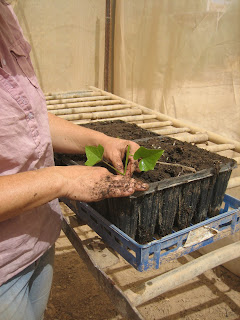Everyone was pretty exhausted from the festival last night, considering we didn't get home till after 11 – our days begin at 6 AM, so anything later than 10:30 is witching hour. We spent the day lazily playing in the garden, weeding and harvesting.
We up-rooted dying plants, including alf-alfa sprouts, fennel, and invasive weeds and trees, creating mulch beds with these plants. All you do is pull them up, then place them on areas that need a little bit of soil lovin' AKA moisture and nutrients. When placed on-top of beds, the plants prevent the soil from drying out and will eventually compost back into the ground. This can be exhausting work, as some roots are quite stubborn and there is a lot of getting up and down. Stretching before and after is highly recommended.
After weeding and mulching, we collected dried chard seeds from dying chard plants to store for the next planting season as well as for future seed-ball activities. Summer time is here, which means that most of the plants here at Lotan will die, sadly enough. It's just way too hot for anything to really flourish here. So after collecting the seeds, we pulled the dying chard up, then placed it back on the ground in order for it to de-compost and give back to the earth. This took quite sometime because there were many plants and many beds to cover. I was finally able to break in my gardening clippers and wowzers, those babies are good!
 |
| Dying chard |
 |
| Chard seeds |
|
We then moved on to working in the covered beds, which was a whole lot cooler, literally. There is a light black tarp over these beds, creating cooler air and a more moist climate. In theory, this climate is conducive for a longer growing/harvesting season and from what I can tell, it works. The plants in this tunnel of coolness seem more alive – greener, fresher, and smell like life. Delicious :)
We harvested 2 kinds of greens, tat soi and mizuna, both in the mustard family. One of my favorite things about working in the garden is if you're feeling a little hungry, it's munch heaven. Needless to say, my roommate and I had a small feast of fresh, leafy green veggies :)
Now we could only harvest a few of these veggies, due to the fact that the rest of the batch was attacked by a parasite that leached itself on the plants like a spider web. It's a parasite that instead of growing out of the ground, somehow sprouts directly onto the plant, jumping from stem to stem, creating a web. When this parasite attacks, the only thing to do is up-root the plants. Sad day, especially if the plants are beautiful and yummy.
We ended the day early, enjoyed a fabulous lunch, then ventured into experimenting with the solar and tabun ovens. Solar ovens utilize mirrors to reflect sunlight onto what you're cooking, whereas a tabun is a thick, clay oven that encapsulates heat in its walls. Dinner is not served on Thursday nights, so the Bustan residents put together a potluck, making all sorts of dishes, mostly utilizing fresh produce and herbs from the garden. I decided to make the fabulous banana cookies :)
The procedure with the solar ovens is as follows:
Anything going in the solar oven must have ventilation on the bottom. Here, the residents place sticks on the bottom of the oven and place whatever they're cooking on top of it.
Place the tray in the oven. Line up the side of the oven with the shadow from the sun. This way, you know the sun is directly shining on the food.
Maneuver the mirror to where the reflection covers most of the food.
Continually check on the oven to make sure it's directly lined with the sun, as well as keeping an eye on the food. From there, you just wait!
The procedure with the tabun is a little different, as it is more closely related to an actual oven. Here's how it works:
Create a fire inside the oven, much like a fire you would create at summer camp for making s'mores :)
Let the fire burn down. This can take up to 20 minutes, so start this early!
After the fire has burned down, move the coals around to make a flat surface. You can even place 2 cold bricks with a rack on-top, creating a level surface to place the food tray.
Place the tray with food in the oven, and close the door.
Both ovens produce quite delicious results, I would say more so than regular ovens. Because of the heating process, the outside of the cookies turned out a little crunchy, whereas the insides were nice and soft. Yummmm :)
 |
| Tabun oven is on the far right-great for making breads and baking! |
The main difference between these ovens and a regular oven is the cooking time – in the solar ovens, it can take anywhere from 10 or 15 minutes to an hour or two to cook something. For the cookies, it took about 30 to 45 minutes, but probably would have taken less time if I hadn’t of kept checking on them.
The potluck was delicious – all kinda of dishes with fresh veggies from the garden, salads, grain dishes, and yummy yummy banana cookies!
So everyone has Friday and Saturday off for Shabbat. I'm really looking forward to sleeping and taking it easy. Some rest is very needed :) Shabbat Shalom!































